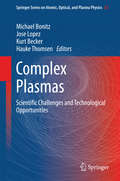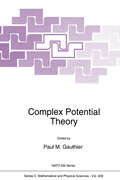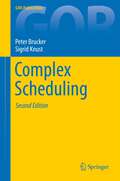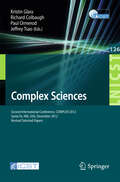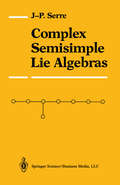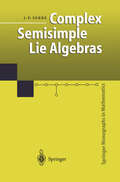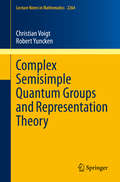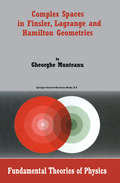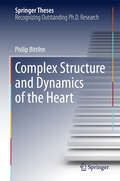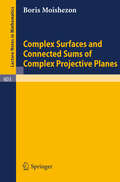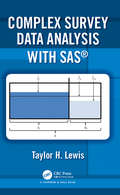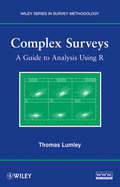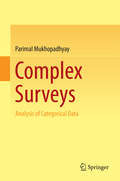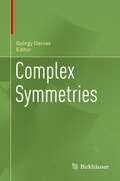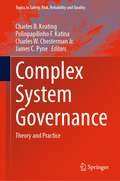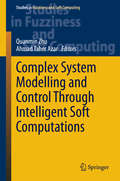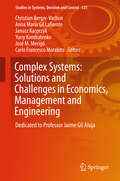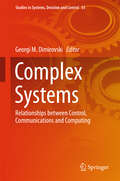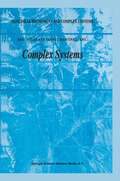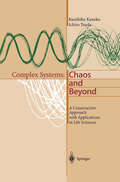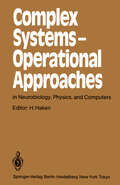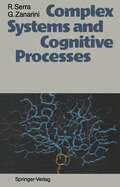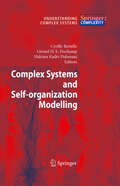- Table View
- List View
Complex Plasmas: Scientific Challenges and Technological Opportunities (Springer Series on Atomic, Optical, and Plasma Physics #82)
by Michael Bonitz Jose Lopez Kurt Becker Hauke ThomsenThis book provides the reader with an introduction to the physics of complex plasmas, a discussion of the specific scientific and technical challenges they present and an overview of their potential technological applications.Complex plasmas differ from conventional high-temperature plasmas in several ways: they may contain additional species, including nano meter- to micrometer-sized particles, negative ions, molecules and radicals and they may exhibit strong correlations or quantum effects. This book introduces the classical and quantum mechanical approaches used to describe and simulate complex plasmas. It also covers some key experimental techniques used in the analysis of these plasmas, including calorimetric probe methods, IR absorption techniques and X-ray absorption spectroscopy.The final part of the book reviews the emerging applications of microcavity and microchannel plasmas, the synthesis and assembly of nanomaterials through plasma electrochemistry, the large-scale generation of ozone using microplasmas and novel applications of atmospheric-pressure non-thermal plasmas in dentistry.Going beyond the scope of traditional plasma texts, the presentation is very well suited for senior undergraduate, graduate students and postdoctoral researchers specializing in plasma physics.
Complex Potential Theory (Nato Science Series C: #439)
by Gert SabidussiProceedings of the NATO Advanced Study Institute and Séminaire de mathématiques supérieures, Montréal, Canada, July 26--August 6, 1993
Complex Scheduling (GOR-Publications)
by Peter Brucker Sigrid KnustThis book presents models and algorithms for complex scheduling problems. Besides resource-constrained project scheduling problems with applications also job-shop problems with flexible machines, transportation or limited buffers are discussed. Discrete optimization methods like linear and integer programming, constraint propagation techniques, shortest path and network flow algorithms, branch-and-bound methods, local search and genetic algorithms, and dynamic programming are presented. They are used in exact or heuristic procedures to solve the introduced complex scheduling problems. Furthermore, methods for calculating lower bounds are described. Most algorithms are formulated in detail and illustrated with examples. In this second edition some errors were corrected, some parts were explained in more detail, and new material has been added. In particular, further generalizations of the RCPSP, additional practical applications and some more algorithms were integrated.
Complex Sciences: Second International Conference, COMPLEX 2012, Santa Fe, NM, USA, December 5-7, 2012, Revised Selected Papers (Lecture Notes of the Institute for Computer Sciences, Social Informatics and Telecommunications Engineering #126)
by Kristin Glass Richard Colbaugh Paul Ormerod Jeffrey TsaoThis book constitutes the thoroughly refereed post-conference proceedings of the Second International ICST Conference on Complex Sciences, COMPLEX 2012, held in Santa Fe, New Mexico, USA in December 2012. The 29 revised full papers presented were carefully reviewed and selected from various submissions. The papers cover aspects on foundations and analysis of complex systems, complex biological systems, complex social systems, complex engineering systems.
Complex Semisimple Lie Algebras
by Jean-Pierre SerreThese notes are a record of a course given in Algiers from lOth to 21st May, 1965. Their contents are as follows. The first two chapters are a summary, without proofs, of the general properties of nilpotent, solvable, and semisimple Lie algebras. These are well-known results, for which the reader can refer to, for example, Chapter I of Bourbaki or my Harvard notes. The theory of complex semisimple algebras occupies Chapters III and IV. The proofs of the main theorems are essentially complete; however, I have also found it useful to mention some complementary results without proof. These are indicated by an asterisk, and the proofs can be found in Bourbaki, Groupes et Algebres de Lie, Paris, Hermann, 1960-1975, Chapters IV-VIII. A final chapter shows, without proof, how to pass from Lie algebras to Lie groups (complex-and also compact). It is just an introduction, aimed at guiding the reader towards the topology of Lie groups and the theory of algebraic groups. I am happy to thank MM. Pierre Gigord and Daniel Lehmann, who wrote up a first draft of these notes, and also Mlle. Franr,:oise Pecha who was responsible for the typing of the manuscript.
Complex Semisimple Lie Algebras (Springer Monographs in Mathematics)
by Jean-Pierre SerreThese short notes, already well-known in their original French edition, present the basic theory of semisimple Lie algebras over the complex numbers. The author begins with a summary of the general properties of nilpotent, solvable, and semisimple Lie algebras. Subsequent chapters introduce Cartan subalgebras, root systems, and linear representations. The last chapter discusses the connection between Lie algebras, complex groups and compact groups. The book is intended to guide the reader towards further study.
Complex Semisimple Quantum Groups and Representation Theory (Lecture Notes in Mathematics #2264)
by Christian Voigt Robert YunckenThis book provides a thorough introduction to the theory of complex semisimple quantum groups, that is, Drinfeld doubles of q-deformations of compact semisimple Lie groups. The presentation is comprehensive, beginning with background information on Hopf algebras, and ending with the classification of admissible representations of the q-deformation of a complex semisimple Lie group. The main components are: - a thorough introduction to quantized universal enveloping algebras over general base fields and generic deformation parameters, including finite dimensional representation theory, the Poincaré-Birkhoff-Witt Theorem, the locally finite part, and the Harish-Chandra homomorphism, - the analytic theory of quantized complex semisimple Lie groups in terms of quantized algebras of functions and their duals, - algebraic representation theory in terms of category O, and - analytic representation theory of quantized complex semisimple groups. Given its scope, the book will be a valuable resource for both graduate students and researchers in the area of quantum groups.
Complex Spaces in Finsler, Lagrange and Hamilton Geometries (Fundamental Theories of Physics #141)
by Gheorghe MunteanuFrom a historical point of view, the theory we submit to the present study has its origins in the famous dissertation of P. Finsler from 1918 ([Fi]). In a the classical notion also conventional classification, Finsler geometry has besides a number of generalizations, which use the same work technique and which can be considered self-geometries: Lagrange and Hamilton spaces. Finsler geometry had a period of incubation long enough, so that few math ematicians (E. Cartan, L. Berwald, S.S. Chem, H. Rund) had the patience to penetrate into a universe of tensors, which made them compare it to a jungle. To aU of us, who study nowadays Finsler geometry, it is obvious that the qualitative leap was made in the 1970's by the crystallization of the nonlinear connection notion (a notion which is almost as old as Finsler space, [SZ4]) and by work-skills into its adapted frame fields. The results obtained by M. Matsumoto (coUected later, in 1986, in a monograph, [Ma3]) aroused interest not only in Japan, but also in other countries such as Romania, Hungary, Canada and the USA, where schools of Finsler geometry are founded and are presently widely recognized.
Complex Structure and Dynamics of the Heart (Springer Theses)
by Philip BittihnThis award-winning thesis investigates the mechanisms underlying cardiac arrhythmia development and termination from an entirely new perspective. By viewing the heart as a complex system, the author uses theoretical tools from nonlinear dynamics combined with numerical simulations and experiments to achieve insights into the relationship between its structure and dynamics, thereby paving the way towards innovative low-energy defibrillation strategies. The work tackles, among other things: the effect of substrate heterogeneity on the spatial-temporal dynamics of cardiac arrhythmias and ways in which weak pulsed electric fields can be used to control these dynamics in heterogeneous cardiac tissue. The long-term vision of this research is to replace the current strategy of applying painful and sometimes tissue damaging electric shock – currently the only reliable way to terminate life-threatening fibrillation – by a more subtle but equally effective intervention. The book maps out a number of promising research directions for biophysicists and medical researchers working on the origins and treatment of cardiac arrhythmias.
Complex Surfaces and Connected Sums of Complex Projective Planes (Lecture Notes in Mathematics #603)
by B. MoishezonComplex Survey Data Analysis with SAS
by Taylor H. LewisComplex Survey Data Analysis with SAS® is an invaluable resource for applied researchers analyzing data generated from a sample design involving any combination of stratification, clustering, unequal weights, or finite population correction factors. After clearly explaining how the presence of these features can invalidate the assumptions underlying most traditional statistical techniques, this book equips readers with the knowledge to confidently account for them during the estimation and inference process by employing the SURVEY family of SAS/STAT® procedures. The book offers comprehensive coverage of the most essential topics, including: Drawing random samples Descriptive statistics for continuous and categorical variables Fitting and interpreting linear and logistic regression models Survival analysis Domain estimation Replication variance estimation methods Weight adjustment and imputation methods for handling missing data The easy-to-follow examples are drawn from real-world survey data sets spanning multiple disciplines, all of which can be downloaded for free along with syntax files from the author’s website: http://mason.gmu.edu/~tlewis18/. While other books may touch on some of the same issues and nuances of complex survey data analysis, none features SAS exclusively and as exhaustively. Another unique aspect of this book is its abundance of handy workarounds for certain techniques not yet supported as of SAS Version 9.4, such as the ratio estimator for a total and the bootstrap for variance estimation. Taylor H. Lewis is a PhD graduate of the Joint Program in Survey Methodology at the University of Maryland, College Park, and an adjunct professor in the George Mason University Department of Statistics. An avid SAS user for 15 years, he is a SAS Certified Advanced programmer and a nationally recognized SAS educator who has produced dozens of papers and workshops illustrating how to efficiently and effectively conduct statistical analyses using SAS.
Complex Survey Data Analysis with SAS
by Taylor H. LewisComplex Survey Data Analysis with SAS® is an invaluable resource for applied researchers analyzing data generated from a sample design involving any combination of stratification, clustering, unequal weights, or finite population correction factors. After clearly explaining how the presence of these features can invalidate the assumptions underlying most traditional statistical techniques, this book equips readers with the knowledge to confidently account for them during the estimation and inference process by employing the SURVEY family of SAS/STAT® procedures. The book offers comprehensive coverage of the most essential topics, including: Drawing random samples Descriptive statistics for continuous and categorical variables Fitting and interpreting linear and logistic regression models Survival analysis Domain estimation Replication variance estimation methods Weight adjustment and imputation methods for handling missing data The easy-to-follow examples are drawn from real-world survey data sets spanning multiple disciplines, all of which can be downloaded for free along with syntax files from the author’s website: http://mason.gmu.edu/~tlewis18/. While other books may touch on some of the same issues and nuances of complex survey data analysis, none features SAS exclusively and as exhaustively. Another unique aspect of this book is its abundance of handy workarounds for certain techniques not yet supported as of SAS Version 9.4, such as the ratio estimator for a total and the bootstrap for variance estimation. Taylor H. Lewis is a PhD graduate of the Joint Program in Survey Methodology at the University of Maryland, College Park, and an adjunct professor in the George Mason University Department of Statistics. An avid SAS user for 15 years, he is a SAS Certified Advanced programmer and a nationally recognized SAS educator who has produced dozens of papers and workshops illustrating how to efficiently and effectively conduct statistical analyses using SAS.
Complex Surveys: A Guide to Analysis Using R (Wiley Series in Survey Methodology #565)
by Thomas LumleyA complete guide to carrying out complex survey analysis using R As survey analysis continues to serve as a core component of sociological research, researchers are increasingly relying upon data gathered from complex surveys to carry out traditional analyses. Complex Surveys is a practical guide to the analysis of this kind of data using R, the freely available and downloadable statistical programming language. As creator of the specific survey package for R, the author provides the ultimate presentation of how to successfully use the software for analyzing data from complex surveys while also utilizing the most current data from health and social sciences studies to demonstrate the application of survey research methods in these fields. The book begins with coverage of basic tools and topics within survey analysis such as simple and stratified sampling, cluster sampling, linear regression, and categorical data regression. Subsequent chapters delve into more technical aspects of complex survey analysis, including post-stratification, two-phase sampling, missing data, and causal inference. Throughout the book, an emphasis is placed on graphics, regression modeling, and two-phase designs. In addition, the author supplies a unique discussion of epidemiological two-phase designs as well as probability-weighting for causal inference. All of the book's examples and figures are generated using R, and a related Web site provides the R code that allows readers to reproduce the presented content. Each chapter concludes with exercises that vary in level of complexity, and detailed appendices outline additional mathematical and computational descriptions to assist readers with comparing results from various software systems. Complex Surveys is an excellent book for courses on sampling and complex surveys at the upper-undergraduate and graduate levels. It is also a practical reference guide for applied statisticians and practitioners in the social and health sciences who use statistics in their everyday work.
Complex Surveys: A Guide to Analysis Using R (Wiley Series in Survey Methodology #565)
by Thomas LumleyA complete guide to carrying out complex survey analysis using R As survey analysis continues to serve as a core component of sociological research, researchers are increasingly relying upon data gathered from complex surveys to carry out traditional analyses. Complex Surveys is a practical guide to the analysis of this kind of data using R, the freely available and downloadable statistical programming language. As creator of the specific survey package for R, the author provides the ultimate presentation of how to successfully use the software for analyzing data from complex surveys while also utilizing the most current data from health and social sciences studies to demonstrate the application of survey research methods in these fields. The book begins with coverage of basic tools and topics within survey analysis such as simple and stratified sampling, cluster sampling, linear regression, and categorical data regression. Subsequent chapters delve into more technical aspects of complex survey analysis, including post-stratification, two-phase sampling, missing data, and causal inference. Throughout the book, an emphasis is placed on graphics, regression modeling, and two-phase designs. In addition, the author supplies a unique discussion of epidemiological two-phase designs as well as probability-weighting for causal inference. All of the book's examples and figures are generated using R, and a related Web site provides the R code that allows readers to reproduce the presented content. Each chapter concludes with exercises that vary in level of complexity, and detailed appendices outline additional mathematical and computational descriptions to assist readers with comparing results from various software systems. Complex Surveys is an excellent book for courses on sampling and complex surveys at the upper-undergraduate and graduate levels. It is also a practical reference guide for applied statisticians and practitioners in the social and health sciences who use statistics in their everyday work.
Complex Surveys: Analysis of Categorical Data
by Parimal MukhopadhyayThe primary objective of this book is to study some of the research topics in the area of analysis of complex surveys which have not been covered in any book yet. It discusses the analysis of categorical data using three models: a full model, a log-linear model and a logistic regression model. It is a valuable resource for survey statisticians and practitioners in the field of sociology, biology, economics, psychology and other areas who have to use these procedures in their day-to-day work. It is also useful for courses on sampling and complex surveys at the upper-undergraduate and graduate levels. The importance of sample surveys today cannot be overstated. From voters’ behaviour to fields such as industry, agriculture, economics, sociology, psychology, investigators generally resort to survey sampling to obtain an assessment of the behaviour of the population they are interested in. Many large-scale sample surveys collect data using complex survey designs like multistage stratified cluster designs. The observations using these complex designs are not independently and identically distributed – an assumption on which the classical procedures of inference are based. This means that if classical tests are used for the analysis of such data, the inferences obtained will be inconsistent and often invalid. For this reason, many modified test procedures have been developed for this purpose over the last few decades.
Complex Symmetries
This volume is a collection of essays on complex symmetries. It is curated, emphasizing the analysis of the symmetries, not the various phenomena that display those symmetries themselves. With this, the volume provides insight to nonspecialist readers into how individual simple symmetries constitute complex symmetry. The authors and the topics cover many different disciplines in various sciences and arts. Simple symmetries, such as reflection, rotation, translation, similitude, and a few other simple manifestations of the phenomenon, are all around, and we are aware of them in our everyday lives. However, there are myriads of complex symmetries (composed of a bulk of simple symmetries) as well. For example, the well-known helix represents the combination of translational and rotational symmetry. Nature produces a great variety of such complex symmetries. So do the arts. The contributions in this volume analyse selected examples (not limited to geometric symmetries). These include physical symmetries, functional (meaning not morphological) symmetries, such as symmetries in the construction of the genetic code, symmetries in human perception (e.g., in geometry education as well as in constructing physical theories), symmetries in fractal structures and structural morphology, including quasicrystal and fullerene structures in stable bindings and their applications in crystallography and architectural design, as well as color symmetries in the arts. The volume is rounded of with beautiful illustrations and presents a fascinating panorama of this interdisciplinary topic.
Complex System Governance: Theory and Practice (Topics in Safety, Risk, Reliability and Quality #40)
by Charles B. Keating Polinpapilinho F. Katina Charles W. Chesterman Jr. James C. PyneThis book explores Complex System Governance (CSG)—an emerging field concerned with the design, execution, and evolution of essential functions necessary to ensure continued viability of a system. The book focuses on three primary development areas to better understand and utilize current developments CSG. First, the conceptual foundations for CSG are developed, from systems theory, management cybernetics, and governance. Second, a set of critical CSG topics are examined from conceptual as well as practice perspectives. Third, several development and application issues are discussed. Ultimately, CSG is positioned as an emerging field with strong theoretical grounding and significant implications for improving practices and performance to better address complex systems and their problems.
Complex System Modelling and Control Through Intelligent Soft Computations (Studies in Fuzziness and Soft Computing #319)
by Quanmin Zhu Ahmad Taher AzarThe book offers a snapshot of the theories and applications of soft computing in the area of complex systems modeling and control. It presents the most important findings discussed during the 5th International Conference on Modelling, Identification and Control, held in Cairo, from August 31-September 2, 2013. The book consists of twenty-nine selected contributions, which have been thoroughly reviewed and extended before their inclusion in the volume. The different chapters, written by active researchers in the field, report on both current theories and important applications of soft-computing. Besides providing the readers with soft-computing fundamentals, and soft-computing based inductive methodologies/algorithms, the book also discusses key industrial soft-computing applications, as well as multidisciplinary solutions developed for a variety of purposes, like windup control, waste management, security issues, biomedical applications and many others. It is a perfect reference guide for graduate students, researchers and practitioners in the area of soft computing, systems modeling and control.
Complex Systems: Dedicated to Professor Jaime Gil Aluja (Studies in Systems, Decision and Control #125)
by Christian Berger-Vachon Anna María Gil Lafuente Janusz Kacprzyk Yuriy Kondratenko José M. Merigó Carlo Francesco MorabitoThis book presents an authoritative collection of contributions reporting on fuzzy logic and decision theory, together with applications and case studies in economics and management science. Dedicated to Professor Jaume Gil Aluja in recognition of his pioneering work, the book reports on theories, methods and new challenges, thus offering not only a timely reference guide but also a source of new ideas and inspirations for graduate students and researchers alike.
Complex Systems: Relationships between Control, Communications and Computing (Studies in Systems, Decision and Control #55)
by Georgi M. DimirovskiThis book gives a wide-ranging description of the many facets of complex dynamic networks and systems within an infrastructure provided by integrated control and supervision: envisioning, design, experimental exploration, and implementation. The theoretical contributions and the case studies presented can reach control goals beyond those of stabilization and output regulation or even of adaptive control. Reporting on work of the Control of Complex Systems (COSY) research program, Complex Systems follows from and expands upon an earlier collection: Control of Complex Systems by introducing novel theoretical techniques for hard-to-control networks and systems. The major common feature of all the superficially diverse contributions encompassed by this book is that of spotting and exploiting possible areas of mutual reinforcement between control, computing and communications. These help readers to achieve not only robust stable plant system operation but also properties such as collective adaptivity, integrity and survivability at the same time retaining desired performance quality.Applications in the individual chapters are drawn from:• the general implementation of model-based diagnosis and systems engineering in medical technology, in communication, and in power and airport networks;• the creation of biologically inspired control brains and safety-critical human–machine systems,• process-industrial uses;• biped robots; • large space structures and unmanned aerial vehicles; and• precision servomechanisms and other advanced technologies.Complex Systems provides researchers from engineering, applied mathematics and computer science backgrounds with innovative theoretical and practical insights into the state-of-the-art of complex networks and systems research. It employs physical implementations and extensive computer simulations. Graduate students specializing in complex-systems
Complex Systems (Nonlinear Phenomena and Complex Systems #6)
by E. Goles Servet MartínezThis volume contains the courses given at the Sixth Summer School on Complex Systems held at Facultad de Ciencias Fisicas y Maternaticas, Universidad de Chile at Santiago, Chile, from 14th to 18th December 1998. This school was addressed to graduate students and researchers working on areas related with recent trends in Complex Systems, including dynamical systems, cellular automata, complexity and cutoff in Markov chains. Each contribution is devoted to one of these subjects. In some cases they are structured as surveys, presenting at the same time an original point of view and showing mostly new results. The paper of Pierre Arnoux investigates the relation between low complex systems and chaotic systems, showing that they can be put into relation by some re normalization operations. The case of quasi-crystals is fully studied, in particular the Sturmian quasi-crystals. The paper of Franco Bagnoli and Raul Rechtman establishes relations be tween Lyapunov exponents and synchronization processes in cellular automata. The principal goal is to associate tools, usually used in physical problems, to an important problem in cellularautomata and computer science, the synchronization problem. The paper of Jacques Demongeot and colleagues gives a presentation of at tractors of dynamical systems appearing in biological situations. For instance, the relation between positive or negative loops and regulation systems.
Complex Systems: A Constructive Approach with Applications in Life Sciences
by Kunihiko Kaneko Ichiro TsudaThis book, the first in a series on this subject, is the outcome of many years of efforts to give a new all-encompassing approach to complex systems in nature based on chaos theory. While maintaining a high level of rigor, the authors avoid an overly complicated mathematical apparatus, making the book accessible to a wider interdisciplinary readership.
Complex Systems — Operational Approaches in Neurobiology, Physics, and Computers: Proceedings of the International Symposium on Synergetics at Schloß Elmau, Bavaria, May 6–11, 1985 (Springer Series in Synergetics #31)
by Hermann HakenA great deal of the success of science has rested on its specific methods. One of which has been to start with the study of simple phenomena such as that of falling bodies, or to decompose systems into parts with well-defined properties simpler than those of the total system. In our time there is a growing awareness that in many cases of great practical or scientific interest, such as economics or the hu man brain, we have to deal with truly complex systems which cannot be decomposed into their parts without losing crucial properties of the total system. In addi tion, complex systems have many facets and can be looked at from many points of view. Whenever a complicated problem arises, some scientists or other people are ready to invent lots of beautiful words, or to quote Goethe "denn immer wo Begriffe feh len, dort stellt ein Wort zur rechten Zeit sich ein" ("whenever concepts are lack king, a word appears at the right time"). Quite often such a procedure gives not only the layman but also scientists working in fields different from that of the in ventor of these new words the impression that this problem has been solved, and I am occasionally shocked to see how influential this kind of "linguistics" has become.
Complex Systems and Cognitive Processes
by Roberto Serra Gianni ZanariniThis volume describes our intellectual path from the physics of complex sys tems to the science of artificial cognitive systems. It was exciting to discover that many of the concepts and methods which succeed in describing the self organizing phenomena of the physical world are relevant also for understand ing cognitive processes. Several nonlinear physicists have felt the fascination of such discovery in recent years. In this volume, we will limit our discussion to artificial cognitive systems, without attempting to model either the cognitive behaviour or the nervous structure of humans or animals. On the one hand, such artificial systems are important per se; on the other hand, it can be expected that their study will shed light on some general principles which are relevant also to biological cognitive systems. The main purpose of this volume is to show that nonlinear dynamical systems have several properties which make them particularly attractive for reaching some of the goals of artificial intelligence. The enthusiasm which was mentioned above must however be qualified by a critical consideration of the limitations of the dynamical systems approach. Understanding cognitive processes is a tremendous scientific challenge, and the achievements reached so far allow no single method to claim that it is the only valid one. In particular, the approach based upon nonlinear dynamical systems, which is our main topic, is still in an early stage of development.
